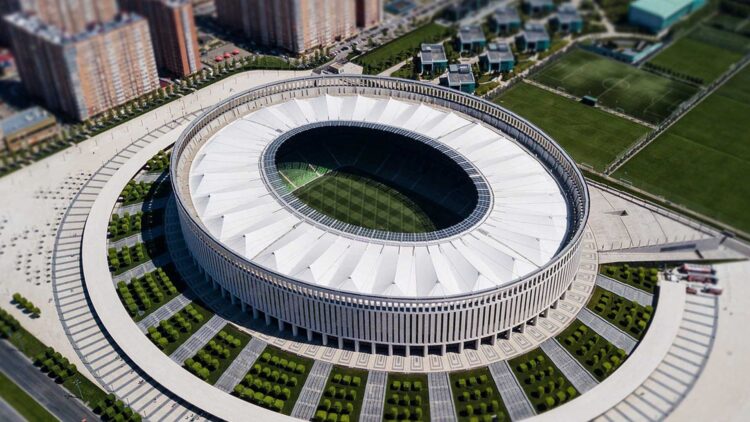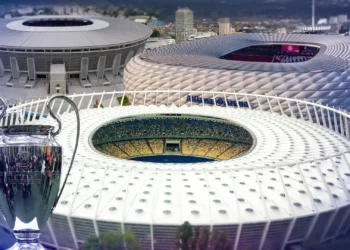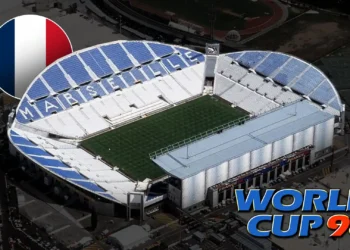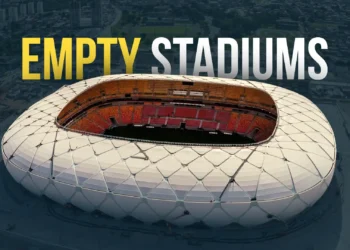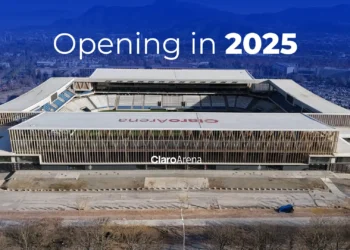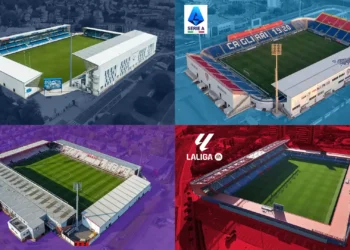What makes a stadium unique? Its design, layout, structure, and the surrounding urban landscape all contribute to its distinct character, setting it apart from others. In an era where stadiums are increasingly looking alike, we’ve selected 10 of the most distinctive in Europe. We’ll also continue this trend by highlighting unique stadiums from every continent.
.
10. Estádio Algarve

Capacity: 30,305 Club: ?
The Algarve Stadium is renowned for its unique and eye-catching architecture. Designed by Portuguese architect Tomás Taveira, it features a sweeping, wave-like roof that mimics the coastal landscape of southern Portugal. The open, airy structure allows for natural ventilation, while the curved stands and vibrant blue and yellow seating evoke the colors of the surrounding sea and sun. Its symmetrical layout, with arches that appear to float above the seating areas, creates a sense of fluidity and space. The design integrates harmoniously with the environment, making it a standout example of modern stadium architecture that blends aesthetics with functionality.
.
09. BayArena
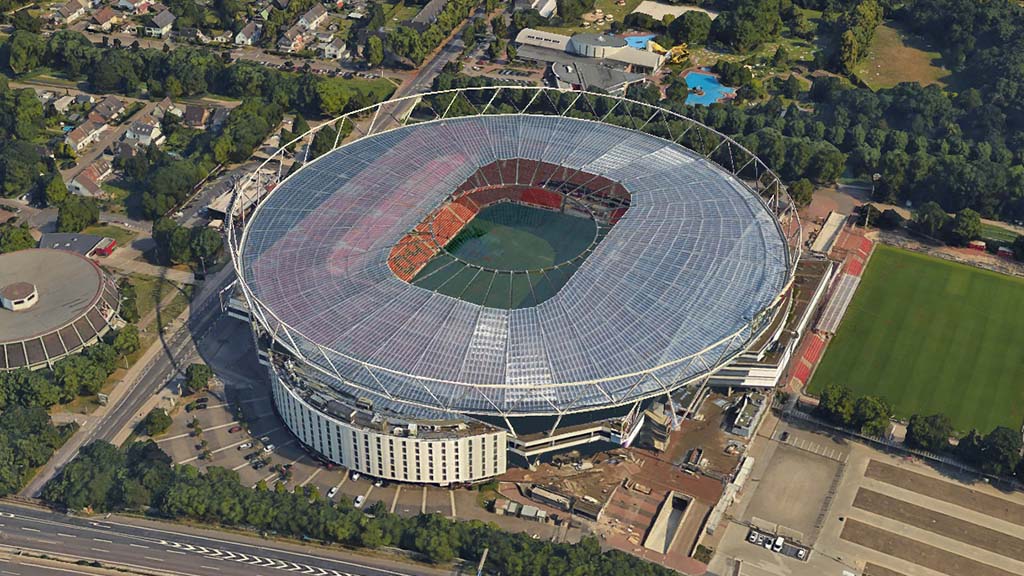
Capacity: 30,2010 Club: Bayer 04 Leverkusen
The BayArena, located in Leverkusen, Germany, is celebrated for its modern and innovative architecture. Its most distinctive feature is the translucent, oval-shaped roof, which stretches over the entire seating area, providing a sleek, futuristic appearance. This roof is supported by a lightweight steel frame, creating the impression that it floats above the stadium. The use of glass and transparent materials allows natural light to flood the interior, enhancing the atmosphere during events. The stadium’s compact, bowl-shaped design ensures excellent sightlines from every seat, while the integration of the roof structure gives it a dynamic and cohesive look. BayArena’s architecture not only emphasizes functionality but also embodies a sense of openness and modernity, making it a visually striking venue.
.
08. Cluj Arena
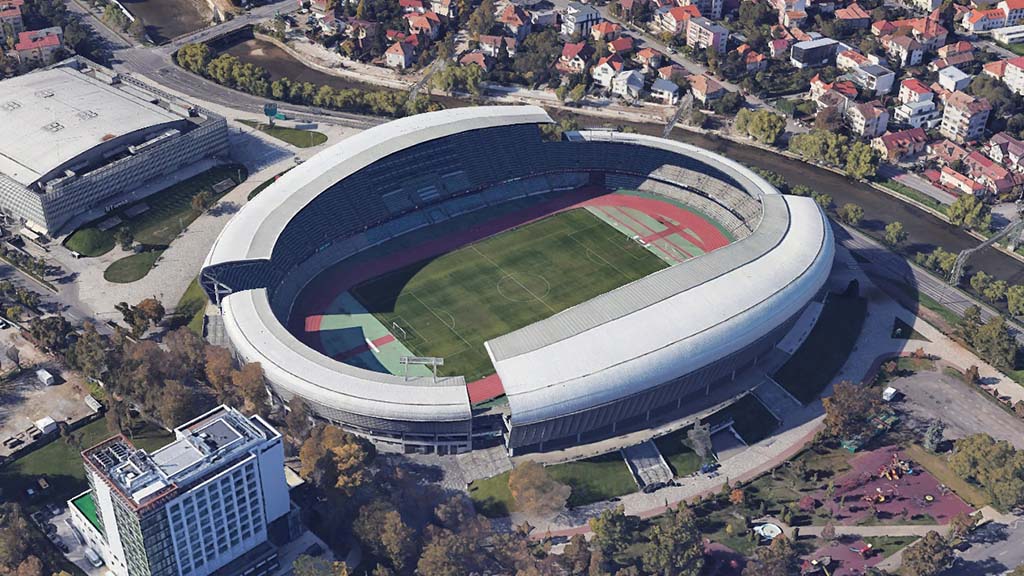
Capacity: 30,201 Club: Universitatea Cluj, Universitatea Cluj & Olimpia Cluj
Cluj Arena, located in Cluj-Napoca, Romania, is a striking example of contemporary stadium architecture known for its modern and functional design. One of the stadium’s most unique features is its distinctive, oval-shaped exterior, which is characterized by a sleek, faceted facade that gives the structure a dynamic and futuristic appearance. The exterior panels, composed of a combination of metal and glass, reflect natural light and create a shimmering effect, making the stadium stand out against the skyline.
The stadium’s roof is equally notable, featuring a modern, retractable design that can be adjusted to provide coverage as needed. This flexible roof structure not only enhances the functionality of the stadium but also adds to its aesthetic appeal. Inside, the seating is arranged in a compact, bowl-shaped configuration that ensures excellent sightlines for every spectator, while the open design of the roof allows for an airy and inviting atmosphere.
.
07. Polish Army Stadium

Capacity: 31,103 Club: Legia Warsaw
The Polish Army Stadium, also known as Stadion Wojska Polskiego, in Warsaw, is a blend of historic charm and modern design. Originally built in 1930, the stadium has undergone several renovations, but its unique character remains. The most notable architectural feature is its elegant, neoclassical facade, which preserves the original structure’s historical significance. The main stands are framed by columns, giving the stadium a grand and almost monumental feel, while modern upgrades have introduced a sleek, bowl-shaped interior with a fully covered seating area.
.
06. Tele2 Arena
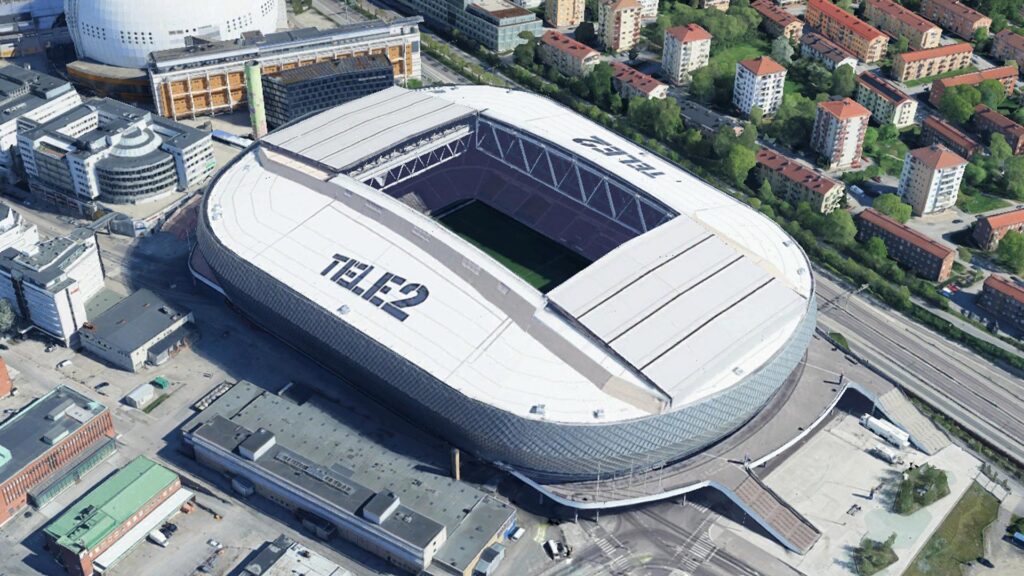
Capacity: 30,000 Club: Djurgårdens IF and Hammarby IF
The Tele2 Arena in Stockholm, Sweden, is a striking example of modern stadium architecture, known for its sleek, futuristic design. Its most iconic feature is the fully retractable roof, which allows the stadium to host both indoor and outdoor events, making it a versatile venue for sports, concerts, and other large-scale gatherings. The exterior is wrapped in a distinctive, shimmering façade made of transparent and semi-transparent glass panels that reflect the changing daylight, giving the stadium a dynamic, glowing effect.
The interior is designed in a compact, bowl-shaped configuration, ensuring optimal sightlines from every seat, while the roof, when closed, enhances acoustics for concerts and indoor events. The stadium’s modern design also emphasizes sustainability, with energy-efficient systems integrated throughout. Tele2 Arena’s unique architecture combines functionality, aesthetics, and flexibility, making it one of the most visually and technologically advanced stadiums in Europe.
.
05. New Tivoli Aechen
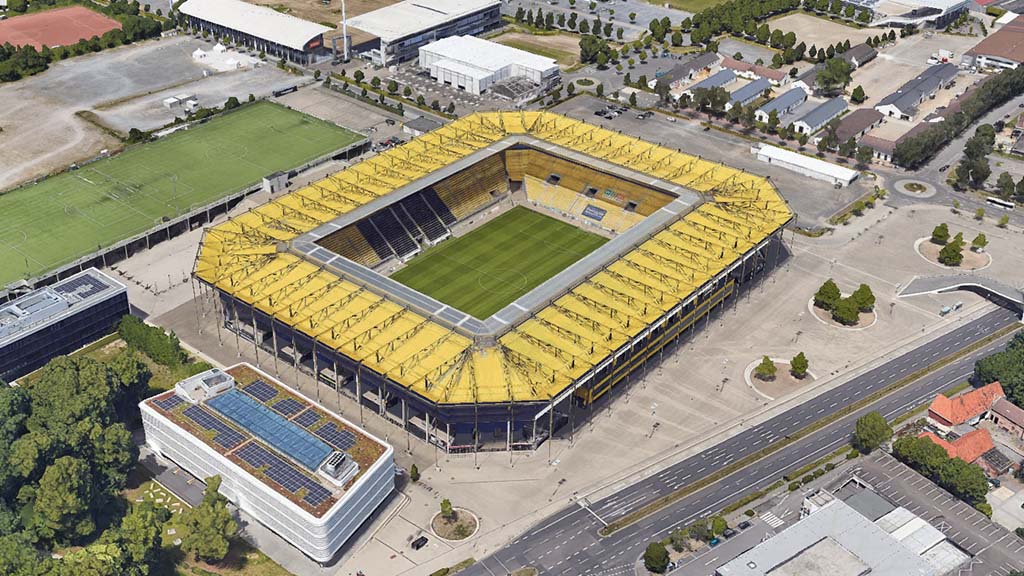
Capacity: 32,960 Club: Alemannia Aachen
New Tivoli Stadium in Aachen, Germany, stands out for its modern, minimalist architecture, which reflects a focus on functionality and fan experience. The stadium’s most distinctive feature is its sharp, angular design, with clean lines and a striking geometric form that gives it a bold, contemporary look. The exterior is clad in a sleek, dark façade with large glass panels, allowing natural light to illuminate the interior and providing a sense of openness.
The seating area is arranged in a compact, rectangular configuration, with steep stands that bring fans closer to the action on the pitch, enhancing the atmosphere during matches. The roof, supported by a simple yet elegant steel framework, extends over all stands, providing shelter while maintaining the stadium’s clean and open aesthetic. New Tivoli’s architecture combines modern design elements with a focus on fan engagement, making it a standout venue in German football.
.
04. Estádio Municipal de Braga
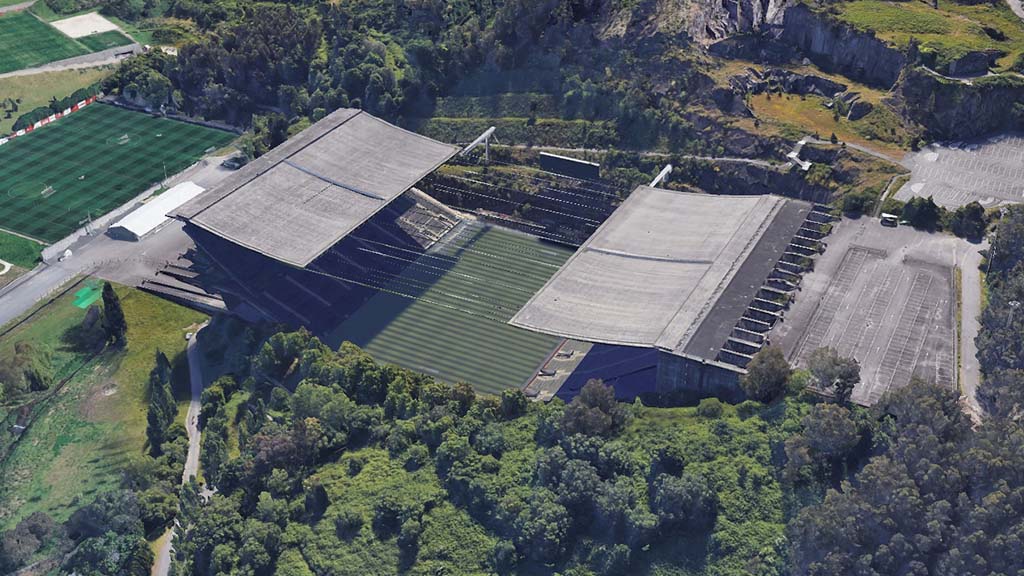
Capacity: 30,286 Club: Sporting Clube de Braga
The Estádio Municipal de Braga, also known as “The Quarry,” is one of the most unique stadiums in the world, celebrated for its remarkable integration into the natural landscape. Designed by renowned Portuguese architect Eduardo Souto de Moura, the stadium is carved into the side of Monte do Castro, a former quarry, giving it an awe-inspiring and dramatic setting.
What sets this stadium apart is its minimalist design, with only two large lateral stands, leaving the ends of the field open to stunning views of the surrounding rock face on one side and the city of Braga on the other. The roof is a striking feature, consisting of slender steel cables that stretch between the two stands, creating a suspended canopy that gives the impression of floating over the stadium. This open, asymmetrical design allows natural light and air to flow freely, while blending seamlessly with the rugged stone backdrop.
Estádio Municipal de Braga’s architecture is a masterpiece of natural integration and modern design, making it not only a functional sports venue but also an iconic piece of architectural art.
.
03. Krasnodar Stadium
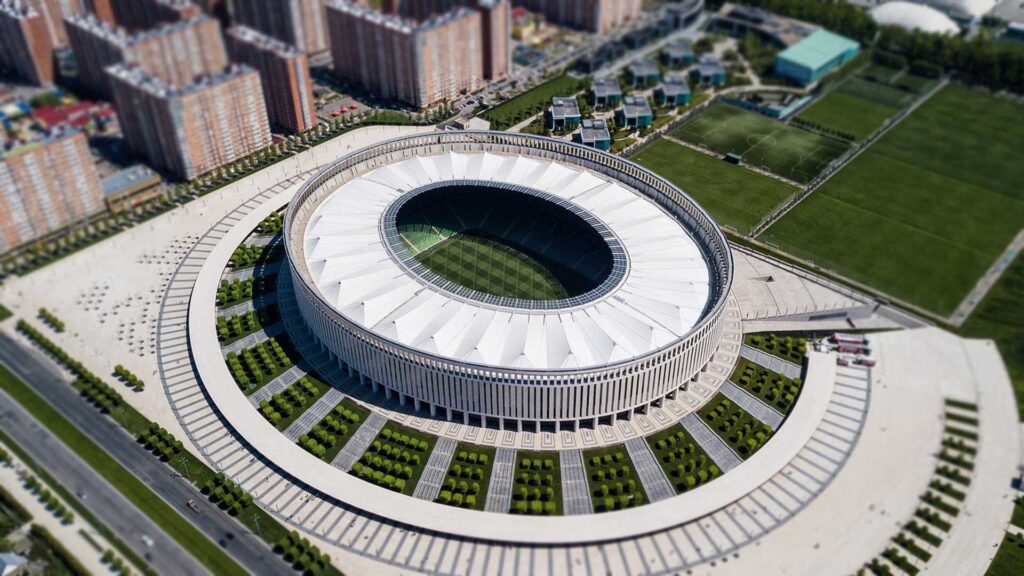
Capacity: 35,179 Club: FC Krasnodar
Krasnodar Stadium, often referred to as the “Kuban Stadium,” is renowned for its striking and innovative architecture. Located in Krasnodar, Russia, the stadium’s most distinctive feature is its circular, open design that resembles a futuristic amphitheater. The exterior is encased in a dynamic, diamond-patterned facade, composed of a series of white, reflective panels that create a shimmering effect and change appearance with varying light conditions.
The stadium’s standout element is its translucent, ring-shaped roof, which extends outward from the central structure, providing coverage while allowing natural light to filter through. This roof design not only enhances the visual appeal but also contributes to the stadium’s acoustics and energy efficiency.
Inside, the stadium features a tiered seating arrangement that ensures excellent sightlines from every angle. The open design of the stadium, combined with its modern materials and innovative roof, creates an impressive and visually captivating venue that blends cutting-edge architecture with functionality.
.
02. Nouveau Stade de Bordeaux
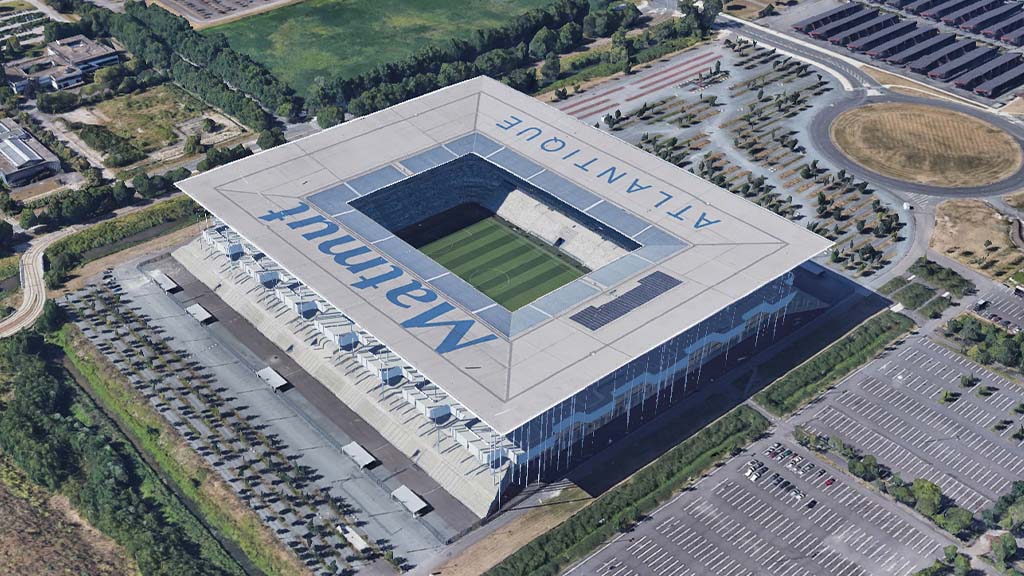
Capacity: 42,115 Club: FC Girondins de Bordeaux
The Nouveau Stade de Bordeaux, also known as the Stade de Bordeaux, is a striking example of contemporary stadium architecture. Located in Bordeaux, France, the stadium is celebrated for its elegant and minimalist design, which seamlessly integrates into its surroundings. Its most distinctive feature is the series of slender, white columns that encircle the stadium, giving it a distinctive, forest-like appearance. These columns, which rise above the seating bowl, create a sense of lightness and openness, while also providing structural support for the canopy roof.
The roof itself is a sleek, curved structure that extends outward, providing coverage for the seats while maintaining an open and airy feel. Its translucent design allows natural light to filter through, enhancing the interior atmosphere and creating a visually stunning effect. The exterior of the stadium features a clean, modern facade that complements the surrounding landscape and contributes to the venue’s sophisticated appearance.
.
01. Aviva Stadium
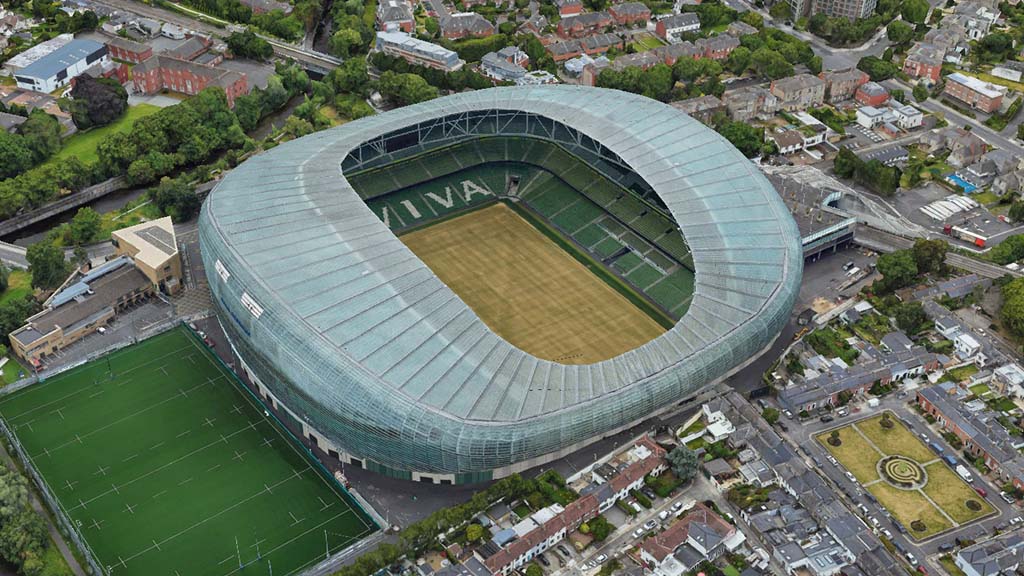
Capacity: 51,700 Club: Football Association of Ireland,
The Aviva Stadium in Dublin, Ireland, is renowned for its distinctive and striking architecture. Its most notable feature is the innovative, undulating roof, which resembles a futuristic, translucent shell. The roof’s curved, lattice-like structure is composed of a network of steel and glass panels, creating a visually stunning effect that allows natural light to permeate the stadium while providing shelter for spectators.
The exterior of the stadium is equally impressive, with a sleek, reflective facade that wraps around the venue, enhancing its modern, aerodynamic appearance. The use of glass and metallic materials gives the stadium a dynamic, ever-changing look that varies with the angle of the sunlight and the surrounding environment.
Inside, the Aviva Stadium’s design emphasizes a close connection between fans and the action on the field, with steeply tiered seating that ensures excellent sightlines from every vantage point. The open-ended design of the stadium’s ends allows for a natural flow of air and enhances the overall atmosphere during events.
.
As we’ve explored, these 10 stadiums exemplify how modern design can harmonize with functionality to create spaces that are both visually stunning and purposefully crafted. Whether it’s the striking wave-like roof of the Algarve Stadium, the minimalist elegance of the Nouveau Stade de Bordeaux, or the dynamic, translucent shell of the Aviva Stadium, each of these structures contributes to the rich tapestry of European architectural innovation.
As stadium design continues to evolve, we can expect even more groundbreaking and unique venues to emerge, pushing the boundaries of what is possible and inspiring future generations. For now, these 10 stadiums stand as testaments to the creativity and vision that shape the world of sports and architecture.

